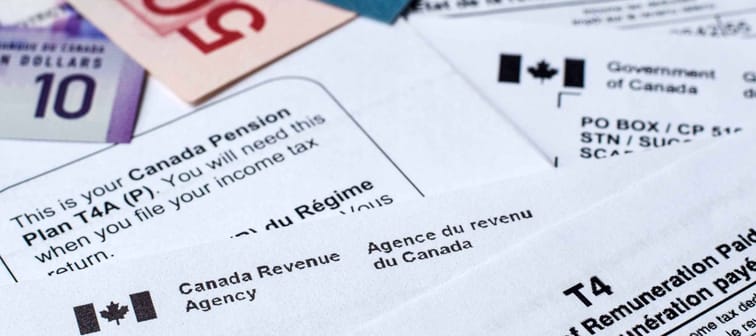What is a tax return?
A tax return is a uniform way for Canadians to file their taxes. It involves reporting your previous calendar year’s taxable income, tax credits and other information to the Canada Revenue Agency (CRA). When you file your tax return, you can either receive a refund or an amount will be payable to the CRA.
If you’re a salaried employee, you’re typically required to file your tax return by April 30 of the following year. For example, you’re required to file your 2021 tax return by April 30, 2022. However, sometimes the tax filing deadline is extended if April 30 falls on a weekend or holiday. If you fail to file your tax return by this deadline and you have taxes owing, you could face both penalties and interest.
If you’re self-employed, you have a little longer to file your tax return—until June 15 of the following year. However, if you owe any GST or HST, it’s still due April 30.
If you’re filing a tax return for someone who passed away, it must be filed by the normal filing deadline of April 30 or six months after the date of death, whichever comes later.
Key terms
Here’s a list of key terms to be familiar with in order to understand the process of filing your taxes.
- Tax Slip: A tax slip is prepared by your employer, payer or administrator. You should receive the majority of your tax slips by February 28.
- Tax Credit: A tax credit is a deduction from taxes you personally owe. Provided you can use the tax credit, each taxpayer receives the same tax benefit, regardless of how much income you earn. There are two types of tax credits: refundable and non-refundable. A refundable tax credit is a tax credit you’ll receive if you’re eligible. A non-refundable tax credit is only available to you when you meet specific conditions.
- Tax Deduction: A tax deduction lowers the amount of your taxable income, depending on your personal marginal tax rate.
- Marginal Tax Rate: A tax system used in Canada where the more taxable income you earn, the more tax you’ll pay. Your marginal tax is the tax you’ll pay on the next dollar of income you earn.
- Tax Brackets: The federal and provincial governments have different tax brackets to calculate how much taxes you owe. Generally, the higher your tax bracket the higher your marginal tax rate.
- Tax Refund: A tax refund is money you get back from the CRA when you remit too much tax.
- Balance Owing: When you have a balance owing, generally, you’re required to file your tax return by April 30 along with the payment or you could face late filing penalties and interest.
Who should file a tax return in Canada?
You’re required to file a tax return in Canada if any of the following situations apply to you:
- You have income taxes owing.
- You received a request to file a tax return from the CRA.
- Your spouse or common-law partner and you choose to split pension income.
- You are in receipt of the working income tax benefit advance payments.
- You disposed of any capital property (e.g., real estate) or you have a taxable capital gain (e.g., mutual funds).
- You’re required to repay employment insurance or old age security benefits.
- You haven’t fully repaid amounts borrowed from your registered retirement savings plan (RRSP) for the Home Buyers’ Plan or Lifelong Learning Plan.
- You’ve made contributions to the Canada Pension Plan (CPP).
- You’re self-employed and you’ve paid premiums for employment insurance and other eligible earnings.
- You’re a non-resident in receipt of certain types of Canadian source income.
Even if none of the above apply to you, you should file your tax return if:
- You’d like to receive a tax refund.
- You’d like to claim the working income tax benefit.
- You’d like to receive the GST/HST credit.
- You and your spouse or common-law partner want to start or continue to receive the Canada child benefit payments.
- You have a non-capital loss that you’d like to apply to other years to reduce your taxes payable.
- You’d like to transfer or carry forward any unused portion of your tuition amount.
- You’d like to report income that you could contribute to your RRSP to keep your RRSP deduction limit up to date for future years.
- You’d like to carry forward any unused portion of the investment tax credit on expenditures that you incurred in the current year.
- You’d like to renew your guaranteed income supplement or allowance benefits under old age security.
If you’re a Canadian living abroad, you can sometimes continue to file your Canadian tax return, even if you aren’t required to do so. The CRA uses these three primary factors in determining your tax residence: dwelling place, spouse or common-law partner, and dependants. If you’re unsure about whether you should be filing your tax return, it’s best to speak with an international tax expert.
Pro Tip: Start a file folder for tax records and receipts that you can organize as they come in. This will make your life a lot easier come tax time.
What documentation do you need to file a tax return?
To help make the tax filing process easier, here’s a list of materials that you should gather before filing:
Tax Slips
- T4 slips for employment income
- Interest, dividends, mutual funds (T3, T5, T5008)
- Employment insurance benefits (T4E)
- Universal Child Care Benefit (RC62)
- Tuition/education receipts (T2202A)
- Old Age Security and CPP benefits (T4A-OAS, T4AP)
- Other pensions and annuities (T4A)
- Social assistance payments (T5007)
- Workers’ compensation benefits (T5007)
Tax Receipts
- RRSP contribution receipts
- Medical expenses
- Professional or union dues
- Support for a child, spouse or common-law partner
- Charitable donations
- Political contributions
- Child care expenses
- Moving expenses
- Interest paid on student loans
- Carrying charges and interest expenses
- Home office expenses
- Exams for professional certification
Other Documents/Information
- All your personal information (SINs of your family members, address, birth date, marital status, dependents, etc.)
- Previous year’s tax return
- Previous year’s Notice of Assessment/Reassessment
- Sale or deemed sale of stocks, bonds or real estate
- Northern resident’s deductions receipts
- Rental income and expense receipts
- Business, farm or fishing income/expenses
- Automobile/travel logbook and expenses
- Disability Tax Credit Certificate
- Declaration of Conditions of Employment (T2200)
- Custody Arrangement documentation
What steps should you take before filing your tax return?
Here are some strategies and actions you can keep in mind to help make the tax filing process easier:
1. Plan ahead
At the beginning of the year, start planning how you’re going to structure your financial affairs to help lower your overall tax bill. For example, you can make regular RRSP contributions throughout the year to lower your taxes owing the following year.
2. Keep records and receipts during the year
Start a file folder for tax records and receipts that you can organize as they come in. This will make your life a lot easier come tax time, as you’ll be less likely to have misplaced receipts and other important tax documents. Include anything related to expenses you’ll be claiming, such as a home office, car expenses, rental properties and more.
3. Make sure you have all your tax slips and receipts
Carefully review the list of tax slips and receipts included above and make sure you’ve gathered all those relevant to you before filing your tax return. Track down any that are missing. Most tax slips must be issued by February 28 of the current year, except T3 slips, which are to be issued 90 days after the trust’s year end.
4. Decide whether you need help
If you have a ‘plain vanilla’ tax return—i.e., you’re a salaried employee with nothing complicated—then you can probably file your own tax return with DIY software. (Check out our picks for the best tax return software on the market.) However, if you’re self-employed, own a rental property or your tax situation is more complex for any other reason, it might be better to seek out professional tax help. A tax expert can help maximize your tax credits and deductions, while minimizing any taxes owing.
If you do decide that you need help, you’ll be thankful that you took the time to organize your tax slips and receipts, as it will most likely save you money when hiring a professional.
What are the different tax forms in Canada?
Here are some basic, common tax forms you should be familiar with when filing your tax return.
T1 General Tax Form: The T1 tax form is what you use to complete your personal income tax return. It has five sections: identification, total income, net income, taxable income and refund/balance owing.
Schedule 1 – Federal Tax: The Schedule 1 tax form is used to calculate your net federal tax. You can also claim your federal non-refundable tax credits and any federal tax you’re required to pay on your taxable income.
Schedule 3 – Capital Gains (or Losses): Schedule 3 is used for calculating the amount of taxable capitals on your tax return. It has eight different sections to complete.
Schedule 7 – RRSP and PRPP Unused Contributions, Transfers, and HBP and LLP Activities: Schedule 7 is used to report any RRSP contributions you made during the year. You’ll also use Schedule 7 if you’re not deducting your full RRSP contributions.
Schedule 9 – Donations and Gifts: Schedule 9 is used for calculating any donations and gifts you made throughout the tax year.
Provincial Tax Forms: The provincial tax forms you’ll complete depend on the province in which you reside. For example, in Ontario you’re required to complete ON428, ON-BEN and ON479. ON428 calculates how much tax is payable to the province; ON-BEN is an application to the Ontario Trillium Benefit and Ontario Senior Homeowner’s Property Tax Grant; and ON479 is used to claim any tax credits that you’re eligible for.
COVID-19 related benefits
To help support Canadians during the pandemic, the Canadian government extended a number of temporary COVID-19 related benefits throughout 2021. These COVID-19 benefits were targeted towards those most affected by COVID-19 from a financial standpoint.
If you received any of these COVID-19 benefits, there are tax consequences.
Canada Recovery Benefit
The Canada Recovery Benefit (CRB) replaced the Canada Emergency Response Benefit (CERB) in September 2020 and lasted until October 23, 2021. It was targeted to those Canadians who were ineligible for Employment Insurance (EI) but had still lost out on work due to the pandemic. The benefit provided $500 per week for a maximum of 26 weeks. To be eligible to receive it you had be an employee who stopped working or your income had been reduced by 50 percent or more because of COVID-19.
Canada Recovery Sickness Benefit
The Canada Recovery Sickness Benefit (CRSB) was a $500 per week benefit that lasted for a maximum of two weeks. To be eligible to receive it you must have been an employee who was unable to work for at least half of the week because you became infected with COVID-19. You must also have been quarantining due to COVID-19. You could also qualify for the benefit if you have a pre-existing condition, were undergoing treatment, or had contracted other illnesses that, in the opinion of a medical practitioner or other health professional, would make you more prone to catching COVID-19. The benefit ended November 20, 2021.
Canada Recovery Caregiving Benefit
The Canada Recovery Caregiving Benefit (CRCB) was a $500 per week benefit that lasted for a maximum of 26 weeks. To be eligible to receive it you must have been unable to work at least half of the week because you needed to care for a child under 12 years old or a family member due to schools, daycares and child care facilities being closed relating to COVID-19. Also eligible was if your child or family member was ill and/or you were required to self-isolate or were considered high risk of serious health issues due to COVID-19. The benefit ended November 20, 2021.
How you’re taxed on COVID-19 related benefits
You’re required to pay income taxes on COVID-19 related benefits just like any other income you receive, whether it be employment income or interest income. You should receive a T4A and/or T4E tax slip for any COVID-19 benefits you received.
For CRB, CRSB and CRCB, a 10 percent withholding tax was applied. This may or may not be enough tax withheld depending on your own personal tax rate. You won’t know until you file your tax return whether you have still have taxes owing.
How long does the CRA take to process tax returns in Canada
You can expect for the CRA to process your tax return and issue your notice of assessment along with any refund owing within two weeks for an electronically filed tax return and eight weeks for a paper-filed tax return. If you’re a non-resident, you can expect to wait 16 weeks. However, it may take the CRA longer to process your tax return if you’re selected for a more detailed tax review. To help speed up the process, you can choose to receive your tax refund via direct deposit.
You can check the status of your tax return online at any time on CRA My Account or by using the MyCRA mobile app. If you prefer, you can call the CRA’s Telerefund service at 1-800-959-1956 to verify the status of your tax return. Be sure to have your tax returns handy from the last two years, as you may be asked to verify information to authenticate your identity.
Once your tax return has been processed, you can expect to receive a notice of assessment in the mail. The notice of assessment includes contact information, statement date information, any actions you need to take and your current balance.







